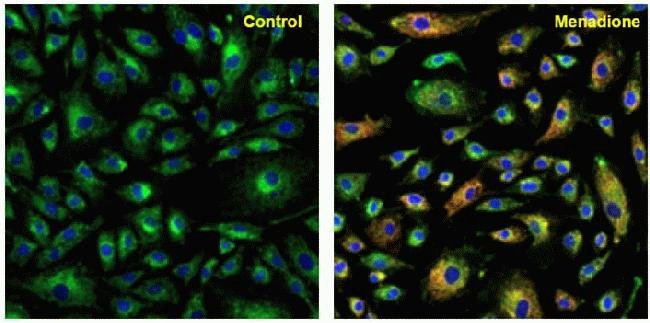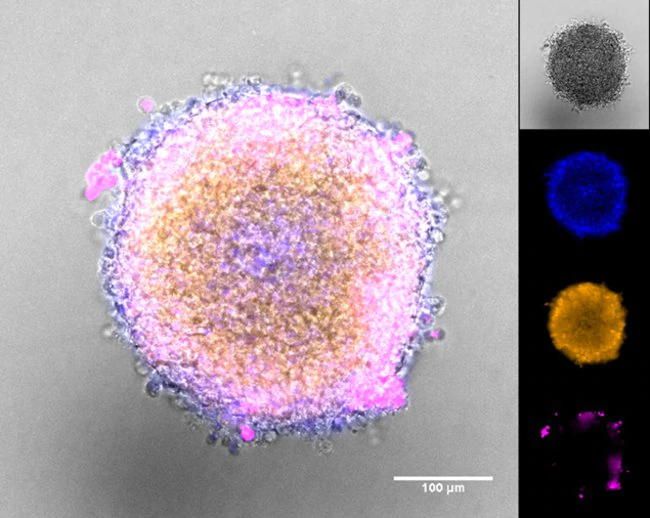描述
CellROX Deep Red Reagent, for oxidative stress detection
氧化应激检测用探针(深红色)
温馨提示:
见我司(懋康生物)整理的活性氧ROS荧光探针专题。
见我司(懋康生物)整理的CellROX Reagent, for oxidative stress detection氧化应激检测探针产品专题。
订购信息:
|
货号 |
产品名称 | Ex/Em(nm) | 规格 | 特价(元) |
| C10422 | CellROX Deep Red Reagent 深红色 | 640/665 | 50 µL |
2290 |
背景介绍:
氧化应激(Oxidative stress)的产生,起因于反应氧物质(ROS)生成与细胞清除ROS之间的不平衡。ROS在几种疾病的发展中发挥重要作用,包括炎症、动脉粥样硬化、衰老和衰老相关的退行性疾病。
基本介绍:
CellROX Deep Red Reagent是一种检测活细胞氧化应激的新型荧光探针。此细胞膜渗透性的染料在还原态时无荧光或呈微弱荧光,一旦被活性氧物质(ROS)氧化后发明亮稳定的荧光,最大吸收/发射波长约~ 644/ 665nm(见图I.CellROX Deep Red氧化后的荧光光谱图)。其荧光信号主要定位在细胞质。
CellROX Deep Red Reagent的深红色荧光信号与其他活细胞染料和GFP兼容,使其适用于多重荧光试验来测定各种细胞现象,包括与细胞毒性和细胞死亡的参数。不同于其它的ROS探针,比如H2DCFDA(MX4802-50MG),CellROX Deep Red Reagent的荧光信号经醛类固定后也能保留,使其相对于传统的ROS探针来说在应用和操作流程更加灵活。CellROX Deep Red Reagent与各种检测平台兼容,比如传统荧光显微镜、高内涵筛选仪器(HCS)、流式细胞仪、荧光酶标仪或高通量筛选(HTS)。还与各种台式仪器兼容,比如Attune™仪器。
产品参数
- 外观:无色溶液(Colorless solution)
- 溶剂:DMSO
- 激发/发射光谱范围:644/665nm(可见光/可见光)
- 亚细胞定位:细胞质
- 荧光颜色:远红(Far-red)
- 保存方法:≤-20°C避光干燥
染色示例

Fig1. BPAE detection of oxidative stress using MitoTracker® Green (Cat. No. M7514) and CellROX® Deep Red Reagent (Cat. No. C10422) BPAE cells were plated in a 96 well plate, treated with 100 µM menadione for 1 hr and then stained with 20 nM MitoTracker® Green, 5 µM Far Red ROS Sensor and Hoechst 33342 for 30 mins in complete medium. Cells were then washed 3X with PBS and imaged on a Thermo Fisher Cellomics ArrayScan® VTI. The control sample has no signal while in menadione treated cells, there is a robust increase in the signal as a result of oxidative stress caused by menadione. Both MitoTracker® Green and Far Red ROS Sensor stained well showing that they work together in a multiplex assay.

Fig2. A549 spheroid mounted with Prolong Glass and imaged with EVOS FL Auto 2. A549 spheroid grown in Nunclon Sphera microplates (Cat. No. 174925) at 1000 cells/well. Live cells were labeled with NucBlue Live ReadyProbes Reagent (Cat. No. R37605), MitoTracker Orange (Cat. No. M7510), and CellROX Deep Red Reagent for oxidative stress detection (Cat. No. C10422) for 1 hour at 37°C. Cells were then fixed with 4% PFA, transferred to a #1.5 coverslip, and mounted in ProLong Glass. Sample was allowed to cure overnight exposed to air, and the coverslip was mounted to the slide using 100% glycerol. Image acquired with EVOS FL Auto 2 (AMAFD2000) using an Olympus 10X air objective (AMEP4753).
常见问题
1)I am trying to label my cells with a reactive oxygen species (ROS) indicator dye, but I am not seeing a significant difference in signal. What could be happening?
First, make sure you have both a negative (untreated) and positive (ROS-induced) sample to compare. A good positive control can be the use of 100 μM menadione for one hour or 50 μM nefazodone for 24 hours. H2O2 can also be used, though it does not work well for CellROX™ dyes. Some dyes, such as H2DCFDA, require esterase cleavage, so don’t incubate in the presence of serum (which contains esterases that can prematurely cleave the dye). If your positive control does not show significant change compared to the negative control, try increasing the concentration and label time for the dye. Our manuals give starting recommendations. Be sure to image your live cells as soon as possible. Only two dyes (CellROX™ Green and CellROX™ Deep Red) are retained with formaldehyde fixation. Finally, make sure you are using filters and instrument settings to match the excitation and emission spectra of the dye.
2)I need a formaldehyde-fixable reactive oxygen species detection assay. Is H2DCFDA fixable?
H2DCFDA and similar derivatives are not fixable. The same goes for dihydroethidium and dihydrorhodamine. However, CellROX™ Deep Red and CellROX™ Green are retained for a limited time upon fixation with formaldehyde. CellROX™ Green may be retained upon subsequent Triton™ X-100 permeabilization. Avoid the use of any acetone or alcohol-based fixatives or fixatives that include alcohol, such as formalin.
3) What dyes can I use to detect reactive oxygen species (ROS) in my bacteria?
Many dyes that are used on mammalian cells have also been shown to be useful in bacterial cells. For example, CellROX Deep Red Reagent has been shown to work in B. subtilis (see Reference: http://www-brs.ub.ruhr-uni-bochum.de/netahtml/HSS/Diss/RaatschenNadja/diss.pdf). If you are interested in a particular dye, but are not sure if it will work on your bacteria, literature searches are the best way to check to see if it has been tested. If not, then it may be worth testing yourself.
注意事项
为了您的安全和健康,请穿实验服并戴一次性手套操作。
— —Written/Edited by V. Shallan【版权归集麒生物/MKBio懋康所有】





